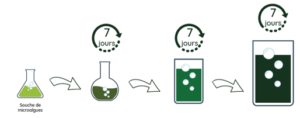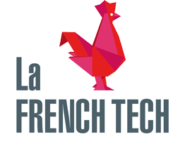Aquaculture refers to the activities of culture of aquatic organisms, from algae to shellfishes (oysters, crustaceans…) to fish. In 2014, the number of French companies in the aquaculture field was up to 3049 and shellfish aquaculture represented a total of 205 000 tons of shellfish and crustaceans which constitutes a financial volume of 678 million of euros.
Phytoplankton is a source of nutrition used by 90% of aquaculture companies in the world. Mastering the culture of those microscopic organisms allows to control the entire chain of production from beginning to animal feeding.
Cultivating their own microalgae is then essential for aquaculture but not without any challenges.
The difficulties of cultivating microalgae in aquaculture
Today, the majority of aquaculture companies uses “traditional” methods for microalgae culture. The most known technic is the one called “sequenced”. Very affordable, it allows to initiate quickly to phytoplankton production and with low costs. However, this method is time-consuming, complicated, instable and with high operation costs.
A time consuming and complicated method
The culture of microalgae in sequenced mode involves re-inoculating regularly of a volume of microalgae to a bearing to increase the volumes to the wanted quantity. This method implies to always have several containers to feed daily the animals in fodder.

Diagram of a production line of microalgae in sequenced mode
To harvest microalgae every day, it is therefore necessary to re-inoculate at least once a day. Also, it is necessary to take into consideration that every re-inoculation implies to start again the washing, disinfection and preparation process for the culture every time and for every container.
Instable cultures, ground for contaminations
At every re-inoculation, it is important to pay attention to the cleanliness of the place where the manipulations are taken place. The aquaculture environment is a playing field for several microalgae predators: other microalgae, bacteria…. The most commonly known are ciliates.
These unicellular protozoan organisms live in lac water, rivers and humid environments. They principally eat microscopic organisms such as bacteria and microalgae. Generally, once the culture in contaminated, ciliates develop rapidly and microalgae only survive a couple of hours.
A less efficient method and very expensive
This traditional method gives very few productivities (between 3 and 8 million of cells/ml in big volumes such as plastic bags or tanks). To feed every animal, it is therefore essential to multiply cultivation equipment. Users of this method will carry a lot of water and will need to work in premises big enough to have a sufficient number of cultivation containers. Real-estate costs and property charges (air-conditioning) represent an important investment.
Solutions for cultivating microalgae in an aquaculture environment
1. Protection of the culture
The aquaculture environment is ideal for extern contaminations by its high humidity rate. The ambient air transports different threats towards the culture (other microalgae, ciliates, bacteria…) and the numerous re-inoculations weaken the culture. So, to protect the culture, it is preferable to cultivate in a closed environment safe from any external contaminations.
2. Having a system capable of producing concentrated quantities of microalgae
Traditional methods in aquaculture produce biomass with low concentration. For example, with T-ISO, cultivation technics in tanks produce concentration of approximatively 5 million cells/ml.
A more performing system will give higher concentration and will limit the number of equipment. The aquaculture farmer will save floor space, save water and by extension decrease the difficulty of work.
With this new system, the production logic will no longer be on the number of liters but in cellular concentration. For example, with our SALT technology, we obtain with T-ISO a concentration of approximatively 130 million of cells per milliliters in batch and 80 million in continuous with a dilution rate of 30%. Thus, a JUMBO of 350L functioning in continuous will by able to replace 28 tanks of 300L + 28 tanks of 30L + 28 flasks of 2L + 28 Erlenmeyer flasks of 250mL… so more than 110 containers to empty, clean and fill up each week. Added benefit of a concentrated culture: the biomass is stronger.
3. Using a production system of microalgae in continuous
Using an equipment capable of doing daily harvest in quantity and of quality is an advantage for cultivating microalgae.
We already have seen that cultivating in a more productive system allows you to save space but also time. The more equipment there is, the most the manipulations will be. Moreover, multiplying manipulations increases the risk of contaminations. Decreasing those manipulation will bring a better stability and quality to the food of the livestock. The production in continuous uses the chamber of culture as a generator of microalgae. Once the reactor has arrived to the wanted concentration, the idea is to water down with a new medium as the microalgae are developing inside. Since the microalgae are dividing quickly, it will be possible to harvest up to 100% of the volume of the chamber, according to the strain, while maintaining a sufficient concentration.
Tools exist to cultivate effectively and easily. At Synoxis Algae, our entire approach of conception is centered on the user and its problematics. We have conceived tools adapted to the need of aquaculturists.
NANO, LUCY and JUMBO answers perfectly these needs and are proven to be a disruptive technology: closed system, high microalgae production (80 million of cells/ml with T-ISO in continuous), possibility to cultivate in semi-continuous, continuous or sequenced. Moreover, we offer to train you on our equipment to have every success key.
4. Regulation the cultivation parameters
To guaranty a daily production of microalgae, it is important to be able to control above all : the pH, the temperature and the light. These elements are essential for the good development of the algae. A light too harsh, a pH too high, an inadequate temperature will be strong barriers to a cultivation project.
Different equipment is able to regulate cultivation parameters. It is possible to integrate a control system.
5. Training the users
Nothing better than knowledge to prevent: water treatment, air treatment… Trained users will set up protocols to cultivate in better conditions and assure the success of the microalgae production.
Good culture !
*Sources :
https://agriculture.gouv.fr/infographie-les-filieres-peche-et-aquaculture
http://agritrop.cirad.fr/524404/



